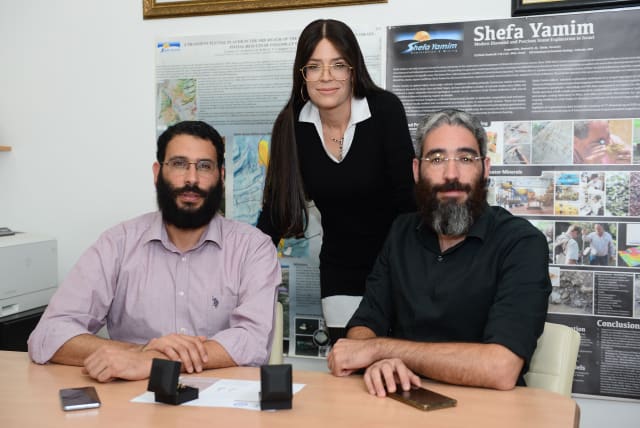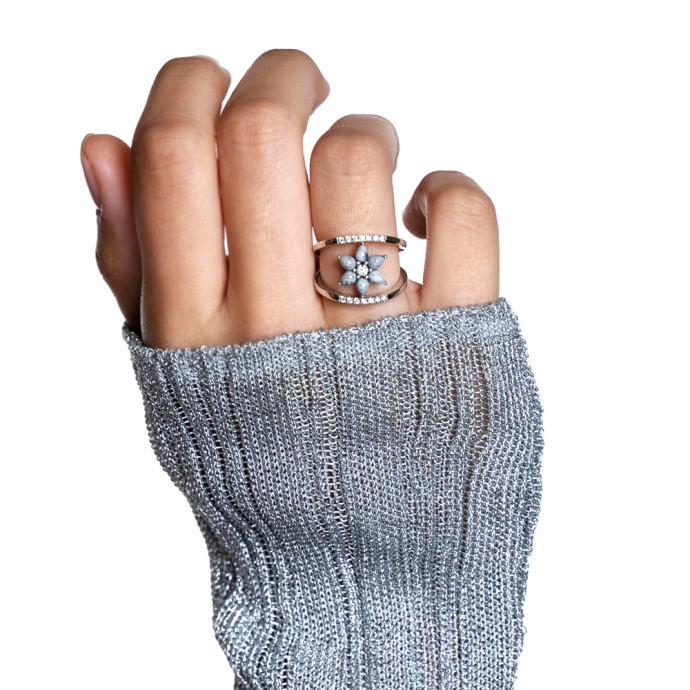Gems from Israel

Holy Gems is bringing precious stones from Israeli mines to the world.
The saga of Holy Gems, the only certified miner and marketer of precious gems from Israel, began in 1988 in Brooklyn, New York, when Rabbi Menachem Mendel Schneerson, the Lubavitcher Rebbe, hosted Aryeh Gur’el (mayor of Haifa from 1978 to 1993).
At that meeting, Rabbi Schneerson, reflecting the words of biblical prophet Isaiah, told Gur’el that God had done a wondrous thing and concealed precious gems deep in the North of the Land of Israel.
When word of the Rebbe’s pronouncement reached Avi Taub, a Netanya-based diamond dealer and jeweler, he decided to search for precious stones in the Holy Land. Despite the doubts of skeptics, Taub, a devoted Lubavitcher hassid, devoted more than two decades to the search before locating a deposit of precious gems in 2019 in the Kishon Valley, near Haifa.
In March 2020, the Israeli government issued a certificate of discovery to Taub’s company confirming the existence of an economic gem deposit in Israel. Taub passed away suddenly three months before the government issued its notification. His children carried on his mission, and a year ago the family established the Holy Gems company to mine, produce, and market these rare gems found in Israel, such as blue, green, and yellow sapphires; red and burgundy garnets; black spinels; and the Carmel sapphire, named after Mount Carmel.
Taub’s daughter, CEO Tali Shalem Taub, explains that Holy Gems is a family-run business. She and two of her brothers make up the Holy Gems management team.
“We took his dream,” says Shalem Taub of her father, “and once we received approval from the government, we established Holy Gems, which is our jewelry retail brand under which we implement our mine-to-market strategy.” Shalem Taub explains that the company controls the gem’s journey from the mine deep in the earth to the hands of the customer. All the stones sold by Holy Gems are set in unique jewelry pieces, such as necklaces, rings, earrings, and bracelets.
Gemstones are formed by chemical changes deep within the earth and come to the surface during volcanic eruptions. Shalem Taub explains that there are two types of mines: primary deposits, which are located where the volcanic eruption occurs, which causes the gems to surface; and alluvial deposits, which are secondary deposits in valleys near the slopes of the mountain, where the stones also can be found
The area of the eruption is called the primary deposit. The Kishon mine, where the first precious stones were found, is an alluvial deposit. Other deposits that Holy Gems is exploring are primary deposits located on Mount Carmel. Alluvial mining, Shalem Taub explains, is less difficult work, as it is easier to locate and excavate the gems than from primary deposits. Mining gems from primary deposits can damage the environment.
“We are developing ways of working in order to comply with the needs of protecting the environment,” she says. “We love Israel, and we love the landscape. We don’t want to damage it. We do what we can to minimize the changes. The importance of protecting the environment in Israel is much more significant than in other places in the world and requires creative thinking and funding. We developed these techniques here because the land is important to us.”
The Carmel sapphire is the most sought-after item at Holy Gems. “People love it and connect to it,” Shalem Taub says. The Carmel sapphire was discovered in Israel in 2014 as a gem-quality corundum with inclusions – a characteristic enclosed within a trapped gemstone – of new minerals never before found on Earth. High gem-quality Carmel sapphires are very rare. The only source in the world for these unique stones is Mount Carmel, and some 2,000 carats have been recovered to date.
“The discovery of this specific precious gem in Israel proves that this land is [also] special geologically,” she says, “not just in spiritual terms.”
A popular recent addition to the Holy Gem line is a new collection developed in partnership with renowned Israeli designer Aviad Arik Herman. It features jewelry based on motifs of the Star of David, the hamsa, and other Jewish symbols.
While the collection was designed before the Gaza war, Shalem Taub says that today, “It fits perfectly with the state of mind of the public. Everybody wants to wear something with the Jewish and Israeli symbol in order to connect. In Hebrew, the magen David translates to ‘David’s shield,’ symbolizing the resilience of our people during challenging times.’”
The war has had a mixed impact on the company, she says.
On the one hand, during this time people want to support Israel and are interested in purchasing gems that come from the Jewish state. Frequently, they are looking for jewelry designs that reflect Jewish meaning, such as a magen David, a map of Israel, or the chai symbol. Additionally, Holy Gems has more classic and traditional jewelry models which are popular among the company’s many non-Jewish – and in particular Christian – customers who feel connected to Israel but for whom it’s “the gem [that] is the story,” she explains.
On the other hand, with the dramatic decline in tourism due to the war, the company was forced to close its two stores in Jerusalem and Acre, near the mining facilities. The company’s visitor’s center in Acre was also shuttered. Holy Gems products are now available exclusively on the company’s website, holy-gems.com, with the company shipping its products around the world. Items on the website range from inexpensive souvenir-style jewelry to luxury items that can cost hundreds of thousands of dollars.
In addition to the products listed in the extensive online store, Holy Gems makes custom jewelry upon request, using specific gems and personalized designs. All Holy Gems jewelry is manufactured in Israel and is accompanied by a gemological certificate signed by a gemologist from one of the leading laboratories in the world.Shalem Taub says that the war has generated some skittishness from investors, who are concerned about the uncertain situation in Israel and around the world.
“Ironically,” she says, “during all the years that we were dealing with exploration, we had no income, and we relied on investors. Now that we found gems, we are in the best-ever position of the company. We have economic deposits, other exploration prospects, and we mine gems and generate income from the sale of jewelry. The market has agreed to the valuation of the gems, which has given a high valuation to the company.
“Now we have all of this prosperity, but it is difficult to find investors. We tell our investors that wars never stopped us and will not stop us now,” she says, adding that Holy Gems is always looking for new partners and collaborations to advance its promising business strategies.
The company would like to reopen its physical stores in Israel in the future but is currently looking into the possibility of opening stores in the US, such as New York, Miami, and Texas, as well as investing in the further development of its online store.
And so, 36 years after the Lubavitcher Rebbe declared the existence of gems in Israel, Holy Gems continues on the path of selling gemstones from the world’s most sacred source – the Land of Israel.
For more information, visit holy-gems.com
This article was written in cooperation with Holy Gems.
Jerusalem Post Store
`; document.getElementById("linkPremium").innerHTML = cont; var divWithLink = document.getElementById("premium-link"); if (divWithLink !== null && divWithLink !== 'undefined') { divWithLink.style.border = "solid 1px #cb0f3e"; divWithLink.style.textAlign = "center"; divWithLink.style.marginBottom = "15px"; divWithLink.style.marginTop = "15px"; divWithLink.style.width = "100%"; divWithLink.style.backgroundColor = "#122952"; divWithLink.style.color = "#ffffff"; divWithLink.style.lineHeight = "1.5"; } } (function (v, i) { });



